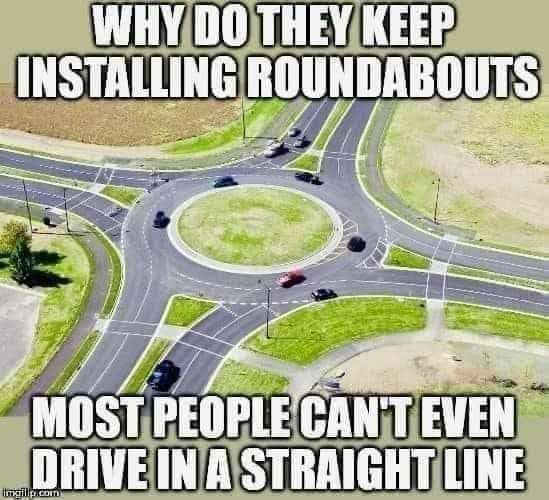Roundabouts are becoming an increasingly familiar sight on roads across the United States. While many drivers appreciate their efficiency, others approach these intersections with a mix of caution and confusion. So, what exactly are roundabouts, and why are they gaining popularity? These traffic features are designed to improve safety and traffic flow, representing a forward-thinking approach to modern roadways.

Here’s everything you need to know about roundabouts—their history, how they work, and why they are being adopted so widely.
What Are Roundabouts, and How Do They Work?
Roundabouts, also referred to as traffic circles or rotaries, are circular intersections where vehicles travel counterclockwise around a central island. Unlike traditional intersections controlled by stop signs or traffic lights, roundabouts rely on a yield-at-entry system. Vehicles entering the circle must yield to traffic already within it, allowing for a smoother and more continuous flow.
The design of roundabouts encourages lower vehicle speeds, as cars enter and exit at angles rather than crossing paths at sharp 90-degree angles. Most roundabouts also feature pedestrian crossings and raised splitter islands, which enhance safety by managing vehicle speeds and providing clear paths for pedestrians.
The History of Roundabouts: From Europe to the U.S.
While roundabouts may feel like a recent innovation, their history dates back centuries. Circular intersections were introduced in European cities like Bath, England, and Paris, France, as early as the 1700s. In the United States, Pierre L’Enfant incorporated circular intersections into his design for Washington, D.C. However, these early iterations lacked the efficiency and safety features of modern roundabouts.
The transformation of roundabouts began in the 1950s when British engineers implemented yield-at-entry rules. This regulation required vehicles entering the roundabout to yield to those already inside, reducing congestion and significantly improving safety. The success of this approach led to its adoption across Europe and Australia, and by the 1990s, roundabouts started appearing in North America.
The first modern roundabout in the United States was constructed in Summerlin, Nevada, in 1990. Since then, their numbers have skyrocketed, with over 10,000 roundabouts now operating across the country.
Why Are Roundabouts Safer Than Traditional Intersections?
The safety benefits of roundabouts are one of the primary reasons for their growing popularity. Traditional intersections, particularly those controlled by stop signs or traffic lights, often see a high number of accidents due to the multiple points where vehicles’ paths intersect.
Here’s a direct comparison:
- Traditional Intersections: A four-way intersection has 32 potential conflict points, including areas where vehicles cross, merge, or diverge. These intersections are prone to right-angle collisions, commonly known as “T-bone” crashes, which can result in severe injuries or fatalities.
- Roundabouts: The circular design reduces conflict points to just eight, and vehicles travel in the same direction at lower speeds. This significantly decreases the likelihood of high-impact crashes.
According to the Federal Highway Administration (FHWA), converting a stop-controlled intersection into a roundabout reduces serious and fatal crashes by 90%. Replacing a signalized intersection with a roundabout results in nearly 80% fewer serious and fatal crashes.
Efficiency and Environmental Benefits of Roundabouts
Roundabouts are not only safer but also more efficient than traditional intersections. Their design eliminates the need for stop-and-go traffic, providing several benefits:
- Reduced Congestion: Continuous traffic flow reduces wait times and minimizes congestion during peak hours.
- Improved Fuel Efficiency: Fewer stops and starts lead to better fuel economy for vehicles.
- Lower Emissions: With less idling and smoother traffic movement, roundabouts reduce vehicle emissions, contributing to a cleaner environment.
In addition to these benefits, roundabouts make U-turns easier, offering drivers greater flexibility in navigating roadways.
Where Are Roundabouts Most Commonly Found?
Roundabouts are typically installed in areas with high traffic volumes or a history of frequent accidents. City planners prioritize them for locations where they can significantly improve safety and efficiency.
Some states, such as New York and Virginia, have adopted a “roundabout first” policy, making them the default option for new or upgraded intersections. Florida leads the nation with approximately 750 roundabouts in operation. Meanwhile, states like North Dakota and Wyoming, with lower traffic volumes and population densities, have fewer roundabouts.
Challenges and Public Perception
Despite their advantages, roundabouts can initially intimidate some drivers. Navigating a roundabout requires yielding to circulating traffic, signaling before exiting, and choosing the correct lane—all of which can feel daunting for those unfamiliar with the process.
However, studies show that public perception improves as drivers gain experience. Communities that initially oppose roundabouts often come to appreciate their benefits, including smoother traffic flow and reduced wait times.
The Future of Roundabouts in the U.S.
The number of roundabouts in the United States has grown exponentially over the past two decades, increasing from just 356 in 2000 to over 10,000 today. This rapid growth reflects a nationwide shift toward safer and more efficient road designs.
The FHWA continues to recommend roundabouts as the safest option for intersections, and many states are incorporating them into long-term transportation plans. With advancements in design and increased public education, roundabouts are poised to become even more common in the coming years.
Conclusion: Roundabouts Are Shaping the Future of Traffic Management
Roundabouts are more than just an alternative to traditional intersections—they symbolize a smarter approach to road safety and efficiency. By reducing conflict points, promoting continuous traffic flow, and lowering emissions, they address many challenges associated with traditional intersections.
While some drivers may still feel hesitant about using roundabouts, their proven benefits make them a valuable addition to modern infrastructure. As more communities adopt this innovative design, roundabouts will continue to transform roadways, making them safer, greener, and more efficient for everyone.
The next time you approach a roundabout, take a moment to appreciate its thoughtful design—and the positive impact it has on your journey.





